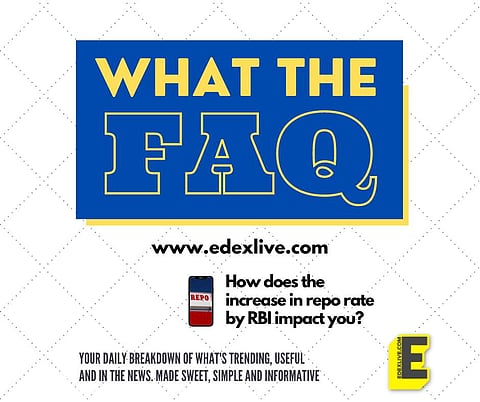

Some major decisions were taken by the Monetary Policy Committee (MPC) of the Reserve Bank of India (RBI). Reeling from two years of pandemic-induced economic slowdown and war, here's what these changes mean for the Indian markets and economy.
What changes have been made to the repo rate?
The MPC, led by RBI Governor, Shaktikanta Das, has increased the repo rate by 50 points, or by 0.5%. The repo rate is the rate at which banks borrow money from the RBI. An increase in this rate means a hike in borrowing rates across the spectrum. Banks are now expected to hike their interest rates for loans, as well as deposit rates. The repo rate had been hiked by 0.4% in May as well.
What is the impact of an increased repo rate?
The hike in the repo rate means that while borrowings for consumers such as home loans will become costlier, it also means that the fixed deposit rates will also be increased. The fixed deposit rate had declined by 40% from 2014 to 2020, according to the Economic Times. In order to check the inflation rate, experts believe that the repo rate is likely to be increased further in the month of August.
How did the committee view inflation?
The RBI has hiked its inflation projections for the financial year 2023 from 5.7% to 6.7%. In fact, the impact of the Russia-Ukraine war, and rising fuel prices across the globe is such that retail inflation in April stood at 7.8% and the central bank has hiked the projections for the period between April to June this year from 6.3% to 7.5%. The upper limit of the inflation tolerance band is 6%, and these figures are significantly pushing it. These projections are on the basis of the assumption that India will have a normal monsoon this year, and the crude oil prices will stay at $105 per barrel.
What were the growth rate projections?
The Gross Domestic Product (GDP) forecast for the financial year 2023 was retained by the RBI at 7.2%. "Urban demand is recovering, rural demand is also improving and while urban demand is recovering, rural demand is gradually improving. Surveys show capacity utilisation in the manufacturing sector increased to 74.5 per cent in January-March," said RBI Governor Das.
When it comes to recurring payments, what was the decision that RBI take?
The limit on the e-mandates for recurring payments has been increased from Rs 5,000 to Rs 15,000. This will apply to debit and credit cards. The RBI had earlier introduced the e-mandates-based method of recurring payments. These covered bills, OTT platforms and other subscriptions, education fee, and insurance premiums. The e-mandate involves sending an Additional Factor Authentication (AFA) during the time of registering for the service, and sending a notification before the amount is debited. The subsequent payments will then not require AFA. This was done to improve safety and convenience in these transactions, said the RBI.
Why did the RBI link credit cards with Unified Payment Interfaces?
For the first time, the RBI has decided to allow users to link their credit cards with their Unified Payment Interface (UPI) IDs. The RBI said that this decision was taken to encourage more people to use UPI, which has 26 crore unique users and five crore merchants in India.
What impact did the meeting have on the housing and realty sector?
The limit on urban and rural co-operative banks for individual home loans has been increased by 100%. This was done to combat the steep rise in housing prices. The RBI has also relaxed the prohibition on rural co-operative banks lending to the commercial real estate and residential housing market. They will now be able to lend to these markets at a limit of 5% of their total assets. Restrictions have also been removed on urban co-operative banks from providing doorstep banking services like commercial banks.
